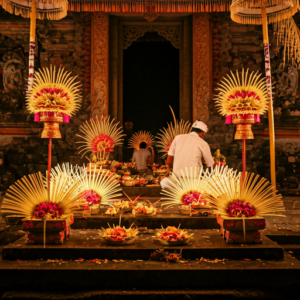
Rising majestically from the heart of the Indonesian archipelago, Mount Agung commands attention as Bali’s tallest and most revered volcano. With its towering peak, dramatic landscapes, and spiritual significance, Mount Agung is not just a geological marvel but also a cultural icon deeply woven into the fabric of Balinese life. In this exploration, we embark on a journey to unravel the mystique and significance of Mount Agung, delving into its geological history, spiritual symbolism, and the profound impact it has on the island and its people.
The Geological Wonder: A History Etched in Stone
Mount Agung, also known as Gunung Agung in the local language, is an active stratovolcano located in the eastern part of Bali. Standing at 3,031 meters (9,944 feet) above sea level, it is the highest peak on the island and forms a stunning backdrop to the surrounding landscape.
The geological history of Mount Agung dates back millions of years, to a time when volcanic activity shaped the island’s rugged terrain. Over time, successive eruptions have sculpted the landscape, leaving behind a legacy of lava flows, ash deposits, and volcanic craters that bear witness to the mountain’s tumultuous past.
Despite its dormant appearance, Mount Agung remains an active volcano with the potential to erupt at any time. The last major eruption occurred in 1963, resulting in widespread devastation and loss of life. Since then, Mount Agung has remained relatively quiet, though periodic seismic activity serves as a reminder of its volatile nature.
Spiritual Symbolism: The Sacred Mountain of Bali
In Balinese Hinduism, Mount Agung is revered as the „navel of the world“ and is believed to be the abode of the gods. It is considered the most sacred mountain on the island and plays a central role in the spiritual and cultural life of the Balinese people.
Throughout Bali, Mount Agung is visible from afar, its towering presence serving as a constant reminder of the island’s spiritual heritage. Pilgrims and devotees flock to the mountain to pay homage to the gods, seek blessings, and participate in sacred rituals and ceremonies.
At the foot of Mount Agung lies the Besakih Temple, known as the „Mother Temple“ of Bali and the largest and holiest Hindu temple on the island. Perched on the slopes of the mountain, Besakih Temple is a sprawling complex of shrines, pavilions, and courtyards that attracts thousands of pilgrims and tourists each year.
Cultural Impact: Mount Agung in Balinese Life
Mount Agung’s significance extends beyond its spiritual symbolism to encompass all aspects of Balinese life. The volcano plays a crucial role in agriculture, providing fertile soil for rice cultivation and supporting a diverse array of flora and fauna.
The water that flows from Mount Agung’s slopes feeds Bali’s rivers and irrigation systems, sustaining the island’s agricultural economy and ensuring the livelihoods of countless farmers and communities. The volcano’s rich volcanic soil is also prized for its fertility, making it ideal for growing crops such as rice, coffee, and fruits.
In addition to its practical importance, Mount Agung also holds cultural significance as a source of inspiration for artists, writers, and musicians. Its majestic beauty and spiritual aura have inspired countless works of art, literature, and music that celebrate the mountain’s enduring legacy and its place in the hearts and minds of the Balinese people.
Preserving Mount Agung: Balancing Conservation and Development
As Bali continues to evolve and modernize, it is essential to strike a balance between preserving Mount Agung’s natural beauty and protecting the island’s cultural heritage while promoting sustainable development and tourism.
Efforts are underway to safeguard Mount Agung and its surrounding ecosystems through conservation initiatives, land-use planning, and environmental education programs. Organizations such as the Indonesian Ministry of Environment and Forestry and the Bali Tourism Board work tirelessly to promote responsible tourism practices that minimize the impact on the environment and respect the mountain’s spiritual significance.
Conclusion
In conclusion, Mount Agung stands as a timeless symbol of Bali’s natural beauty, spiritual heritage, and cultural identity. From its towering peak to its fertile slopes and sacred temples, the volcano holds a special place in the hearts and minds of the Balinese people, who revere it as the „navel of the world“ and the abode of the gods.
As guardians of Mount Agung, it is our collective responsibility to preserve and protect this majestic volcano for future generations to cherish and enjoy, ensuring that its timeless beauty and spiritual significance endure for centuries to come. Through education, advocacy, and sustainable development practices, we can ensure that Mount Agung remains a source of inspiration, reverence, and wonder for all who behold its majestic presence on the island of Bali.





